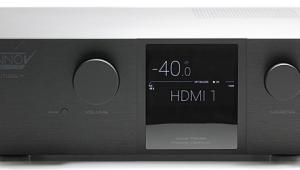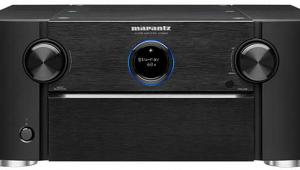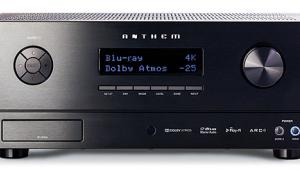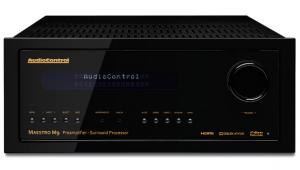McIntosh MX134 Preamp/Processor & MC206 Amplifier Page 2
 Although I preferred the unprocessed Pure Stereo mode, the three music-processing modes were admirable for their light touch. Music 3 (based on Pro Logic II) provided a nice expansion for the vocals, banjo, and guitar on Rebecca Pidgeon's Four Marys CD, as well as on Pink Floyd's "Money." Music 1, which re-creates a large or outdoor setting, was more suitable for the soaring of Carla Lother's "Jaelish" on the Ephemera SACD. Music 2's smaller-room mode did a superb job of re-creating the space in which you'd listen to Quartetto Gelato's eclectic accordion-dominated mix. For each sound mode, trim-select and trim-level knobs (also adjust-able from the remote) allow easy adjustments of up to +/-12 dB to the volume levels of the center, subwoofer, and surround speakers. You can save all of the levels in permanent memory except for the movie modes, which revert to zero when the MX134 is turned off. You can also save bass, treble, and loudness-compensation-trim adjustments for each input in permanent memory. Loudness compensation, by the way, is a variable circuit that boosts the loudness by as much as 18 dB at low-volume listening levels (when the bass becomes harder for the human ear to hear) and gradually decreases the boost as the volume level increases. When engaged, it's simple and automatic—exactly as loudness contour should be.
Although I preferred the unprocessed Pure Stereo mode, the three music-processing modes were admirable for their light touch. Music 3 (based on Pro Logic II) provided a nice expansion for the vocals, banjo, and guitar on Rebecca Pidgeon's Four Marys CD, as well as on Pink Floyd's "Money." Music 1, which re-creates a large or outdoor setting, was more suitable for the soaring of Carla Lother's "Jaelish" on the Ephemera SACD. Music 2's smaller-room mode did a superb job of re-creating the space in which you'd listen to Quartetto Gelato's eclectic accordion-dominated mix. For each sound mode, trim-select and trim-level knobs (also adjust-able from the remote) allow easy adjustments of up to +/-12 dB to the volume levels of the center, subwoofer, and surround speakers. You can save all of the levels in permanent memory except for the movie modes, which revert to zero when the MX134 is turned off. You can also save bass, treble, and loudness-compensation-trim adjustments for each input in permanent memory. Loudness compensation, by the way, is a variable circuit that boosts the loudness by as much as 18 dB at low-volume listening levels (when the bass becomes harder for the human ear to hear) and gradually decreases the boost as the volume level increases. When engaged, it's simple and automatic—exactly as loudness contour should be.
The MX134's digital video circuit upconverts composite video to S-video and component (plus S-video to component), so you only need to run one type of video cable to your display. Although it's another element of simplicity that I appreciated, it's the one area in which I found something to be disappointed with in the MX134. In general, the preamp's video quality was impeccable; however, while watching the upconverted composite output of the Fifth Element DVD, I noticed slight step-by-step variations in the picture's brightness. A few other DVDs had similar, although lesser, variations, while some had none. The results were identical whether the MX134 was converting composite or S-video to component. John Henkel clued me in to why this effect occurred only on certain DVDs with one word: Macrovision. Without getting into the various sides of the copyright debate, suffice it to say that this problem is more a legal than a technical issue. In the end, unless you watch a lot of Macrovision-encoded VHS tapes or haven't upgraded your DVD player to take advantage of your TV's component video inputs, it probably won't be much of an issue. For watching time-shifted recordings, camcorder tapes, and (yes) those mind-numbing video games, the upconverter works fine—and, of course, the MX134 does a spectacular job of passing along the input signal in its original form.
One minor thing that I disliked is that you can't directly access a listening mode from either the MX134's front panel or its remote control. Instead, you have to toggle through the settings one by one. This isn't a bother when you're using the knob on the front panel, but it's a pain in the posterior if you're using the remote control. In my impatience, I usually overshot the setting I wanted and had to go around the dial a second time.
While there's less to say about the MC206 amplifier, it's no less awe-inspiring than the MX134. Aside from the drop-dead-gorgeous blue meters, its most endearing feature is the elegant Power Guard circuit. A standard of McIntosh amplifiers for years, Power Guard continuously monitors each amp channel's distortion level. If any channel is overdriven, Power Guard reduces that channel's input volume to keep the distortion level below 2 percent. It's quick, automatic, and virtually inaudible. Generally, the only way to tell that Power Guard has kicked in is by the flash of the Power Guard front-panel lights above the meters. The worst (and I mean that in a positive way) that Power Guard does is ultimately limit the dynamic range if you're listening at a really loud level. It sure beats lugging your speakers in to have the tweeters replaced.
Sonically, the McIntosh combination never called attention to itself. It was most impressive in its neutrality and ability to confidently handle loud and soft effects with equal aplomb. Whether it was the airborne destruction of Pearl Harbor or the dramatic all-speaker onslaught of "Bohemian Rhapsody" from Queen's newly remixed A Night at the Opera DVD-Audio release, the pair never flinched. Yet, with a cappella music from Anonymous 4, the pre/pro and amp allowed the beautiful and subtle harmonic interplay of voices to fully blossom through my Sonus Faber Grand Piano speakers.
With its stout, sturdy nature, the simplicity of its setup and operation, and its natural and unhindered sound quality, this pre/pro-and-power-amp combo from McIntosh is one of the most profoundly enjoyable packages I've played with in a long time. It's unassuming simplicity masks the complex and meticulous engineering inside, making it a perfect setup for anyone who truly values performance but doesn't want to dedicate his or her life to learning how to operate the gear. If you thought McIntosh was just for old fogies, think again. Class and performance like this never go out of style.

�HIGHLIGHTS
• Silkscreening behind the glass panels never wears off
• Simple and easy-to-operate multiroom capability
• Power Guard prevents damaging distortion from reaching your speakers
- Log in or register to post comments






























































